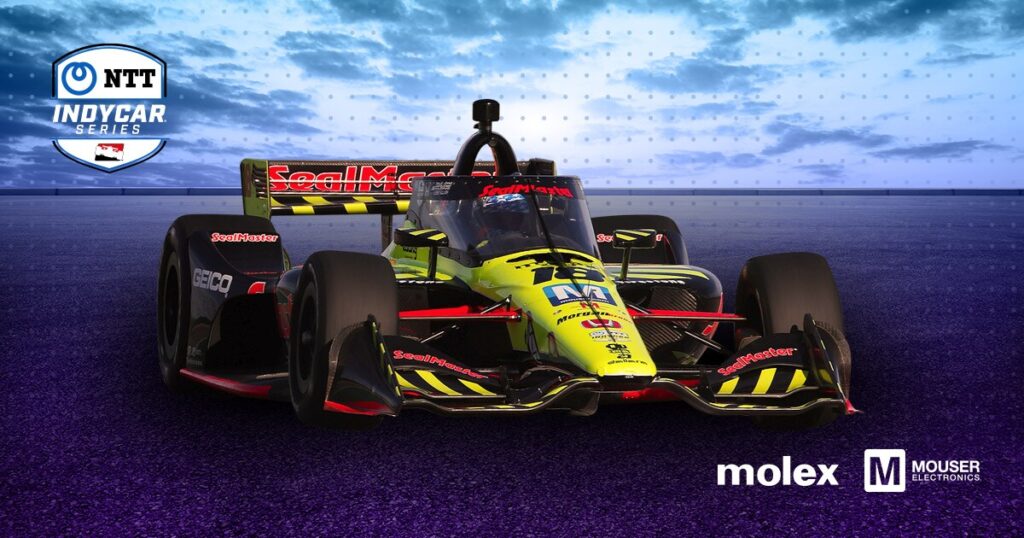IndyCar races take place all over the country on a variety of track types. An oval in Texas, a road course in Alabama, and a street circuit through downtown Long Beach make up just a small part of the schedule. They all vary in length, design, and elevation. This makes preparing for an IndyCar race a very daunting task. Each track type and location introduce unique problems and challenges that teams must face. But they all have one constant: All courses present harsh environments for electronic components inside the cars.
 Harsh environmental factors include temperature, vibration, and pressure, as well as dust and grit (racing is outside, after all). Team engineers and mechanics must come up with creative solutions to mitigate the negative effects of these factors—that gold foil around the engine bay isn’t just for looks. The teams’ Data Acquisition Engineer (DAG) is responsible for measuring and accounting for these variables around the sensitive electronic components of the car. Proper understanding and mitigation of the harsh conditions keep various sensors and computer systems in working order, week in and week out.
Harsh environmental factors include temperature, vibration, and pressure, as well as dust and grit (racing is outside, after all). Team engineers and mechanics must come up with creative solutions to mitigate the negative effects of these factors—that gold foil around the engine bay isn’t just for looks. The teams’ Data Acquisition Engineer (DAG) is responsible for measuring and accounting for these variables around the sensitive electronic components of the car. Proper understanding and mitigation of the harsh conditions keep various sensors and computer systems in working order, week in and week out.
Thermal management is a major concern, as temperatures can reach upward of 1000°C. High temperatures put sensors, wires, and other electronic components at risk of overheating. Brake caliper and rotor temperatures are measured to give the engineers a better picture of the conditions inside the wheel rims, as well as providing insight into the car’s braking performance. Keeping electronic components from overheating while in a confined space with minimal airflow is a difficult task. Teams use heat shielding where possible and high-quality wire for all components on the car.
An IndyCar can reach speeds of around 386 km/h, with cars’ wings and floors creating a downforce of over 3,000kg. But these high forces are difficult to measure accurately without destroying sensors. Team engineers measure wheel load—the amount of weight put on a single wheel, which is critical to the handling performance of the racecar. Most teams use either strain gauges applied to suspension components or load cells for this measurement. Monitoring these loads can also identify issues with mechanical components before failure.
Controlling and understanding vibrations can have a huge effect on the performance of the car. Similar to standard street vehicles, IndyCar team engineers must find ways to lessen the negative effects of vibrations. On a race car, vibrations are amplified by the non-compliant (that is, solid) suspension components and pose a greater threat to electronic components. Teams combat severe vibrations by mounting sensors and electronic controls in a way that limits the transmission of high-frequency vibrations that can easily damage the internal electronics. All mission-critical sensors are given mileage limits, similar to an oil change interval, to prevent failure.
Each IndyCar race has its unique challenges, but general harsh environment problems are present throughout the season. Each team spends many hours measuring, studying, testing, and adjusting their car’s performance to solve these problems and to ensure a successful and safe race.
Next time you watch an IndyCar race, take a moment to think of all the hard work and preparation that goes into getting the car on the track—from component selection and car design to drivers’ skill and teamwork. You might just appreciate what you’re seeing a little bit more. I know I sure do.
Mouser Electronics is proud to sponsor the Dale Coyne Racing with Vasser-Sullivan team for the 2020 season alongside valued manufacturer partner Molex. For more race updates, visit https://www.mouser.com/indy-racing.






